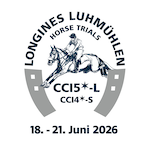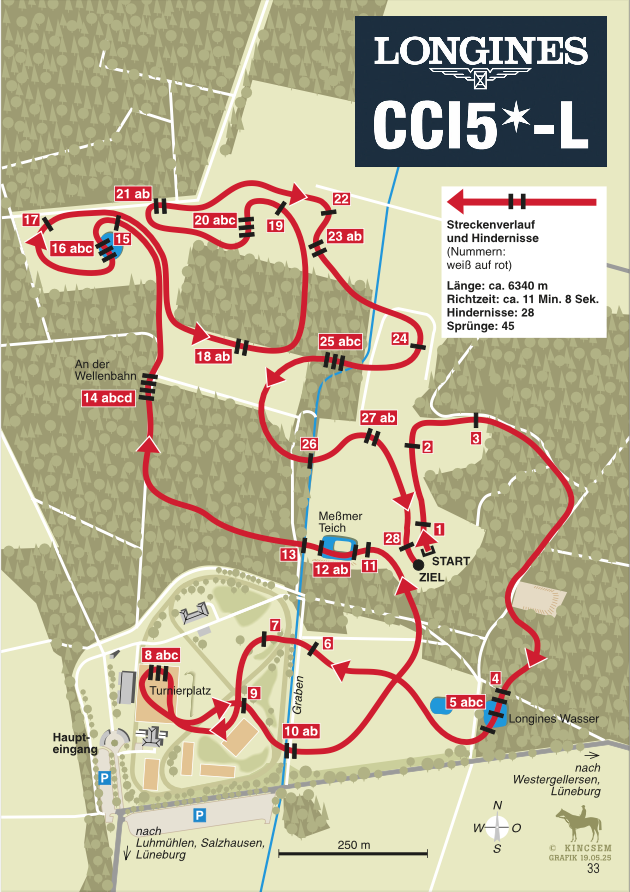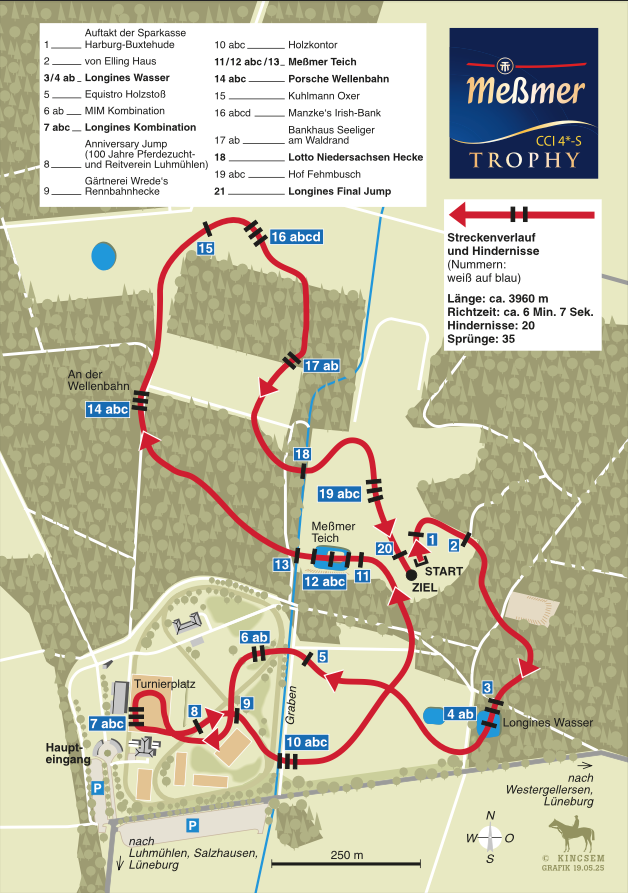Longines CCI5*L-Course Notes by Mike Etherington-Smith
As I write these notes we are putting out the fences for this year’s competition and over the next 3 weeks the courses will come to life. This is the fun part. The plans are made towards the end of last year, confirmed in February, and then, once the fences are sited, the dressing and how the brush is cut will have an impact on the degree of difficulty.
The courses have changed direction this time with some new questions and a new feature fence for both classes. This year the European Championships are in September at Blenheim Palace in the UK and many will be wanting to make an impression on the selectors to win a slot on the team which adds a little bit more interest and a bit more pressure on some of the athletes.
As always I hope that everyone benefits from their ride and has a positive experience and my thanks to David Evans and all involved for all their hard work in preparing the courses to such a high standard, and a big thank you to the many volunteers who give their time so freely to make the day work.
The three early fences Auftakt der Sparkasse Harburg-Buxtehude (1), Willke Tisch (2), and the Busch Oxer (3), are up to height and spread and, as always, are there to settle any nerves (horse and rider) and allow them to get into a good, confident rhythm with the horses jumping in a good shape.
The Longines Wasser (4), (5abc), the first question on the course, comes early this year. The coop (4) has quite a drop and will jump big before riders have to prepare for the brush into water with a near maximum drop (the maximum permitted drop is 2 meters) and then curve on 4 or 5 strides to one of the boats followed by 3 strides to a curved brush at the top of the slope. Horses and riders need to be switched on by now, feeling confident and getting their line right or a run out (20 penalties) will be all too easy.
A bit of a breather as they head down the hill to the Equistro Holzstoß (6), a straightforward fence albeit at maximum height and spread, and then to the MIM-Ecke (7) behind the sponsor tent. The MIM system is a safety development in the sport introduced some 10 years ago which is designed to help reduce the possibility of a rotational fall. Should a horse hit the fence hard it will collapse (it can be quickly reset) and this will incur an automatic 11 penalties.
Into the main arena for the Longines Kombination (8abc), a maximum oxer (spread fence) followed by two angled brush fences on 1 stride. This is to look at the rider’s ability to set their horses up well and to be able to hold a line and to explore the horse’s honesty.
An old favourite comes next, the Gärtnerei Wrede’s Rennbahnhecke (9), straightforward although at maximum height for a brush fence (1.45m), before the two angled logs Holzkontor (10ab), which were in last year and should be ‘food and drink’ at this level.
The Meßmer-Teich (11/12ab/13) is busy and intense as always. Horses come around the corner and there is a lot for them to take on board in terms of people and atmosphere as well as the actual fences they have to jump. This year the direct route consists of a set of MIM rails with a drop heading into the water, a big, narrow triple brush on the island followed by another skinny fence (what we refer to as a carrot box but not sure why!) at the top of the slope coming out of the water for the second time, to then finish over the very nice Mill House. This is a test of athleticism, honesty, good riding, and confidence on the part of horse and rider and there is a long, very slow, route for those who may not be having their best day.
A bit of a breather through the woods before coming to the Porsche Wellenbahn (14abcd) which has a new look. As horses approach the house at the top of the slope they can’t see what follows until they get to the top. Now down this slope to the drop and the two offset brushes. How they jump the house will determine what happens thereafter. The drop should cause no issue at this level yet how horses jump it will determine how well they get to the two offset brushes which really invite run outs unless the line is spot on. Another test of riding ability and horse confidence.
The Niedersachsenpferde (15) is what we call a let-up fence insomuch as it is straightforward allowing horse and rider the opportunity to regroup and have a breather after the intensity of the last 2 combinations as they make their way to the LeMieux Lagune (16abc). Here there are two big brush corners, one just before the water (16a) to then run into the water to the 2nd corner (16b) on 5 or 6 strides depending on the line the riders choose to take, before a curving 3 to a big spread (16c) to finish with. This is all about riding, confidence, and good preparation and presentation. If anyone is in a tangle after the 2nd corner they can opt to take a long, time-consuming route.
The Tisch (17) is another ‘run and jump’ fence even though it is big, and double of the Gatter (18ab) is there to help me as Course Designer make the time (time is an important part of the competition) have some level of influence by slowing the riders down for a short distance.
Through the trees once more to the Busch Oxer (19) which leads on to the new feature fence on this year’s course, the Manzke’s Irish Bank (20abc). We don’t see many of these nowadays and it will be interesting to see how the riders do here. They need to have a plan because as they approach there is no indication that on the other side of the bank having come off it there is a difficult skinny triple brush on 2 strides. As Course Designer I like this sort of fence because riders have to react to how their horses work their way over the bank. There is a degree of unpredictability about this. Horses who are nimble, quick on their feet, and are quick thinkers will have it all worked out and riders have to be quick witted to go with their horses and try not to overthink it.
The Bed & Breakfast (21ab) are on a gentle right curving 3 strides to then head back to the Reiterbar (22) and the MIM-Ecken (23ab) also on a curving left 3 strides. These corners require a good line and good riding, and honesty and athleticism from the horses – another pair of fences where a run out is frustratingly easy.
The Fledermaus Hotel (24) is new. It is another fence with MIM clips on and allows a breather after the intensity of the previous 2 minutes before reaching the Coffin (25abc). The MIM (25a) rails require setting up for correctly since it is another of the MIM fences on the course. It is a fence that has been on the then unfold nicely for them if the rider has presented his/her horse well but there is an alternative, time consuming route to the angled log if anyone needs it.
From hereon it should be pretty straightforward. The Lotto Niedersachsen Hecke (26) looks huge yet always jumps well and just needs positive riding. The Voltaire Oxer (27ab) and the Longines Final Jump (28) are not difficult fences in their own right but they are big enough plus I have made them frangible using the MIM system again and so riders need to make sure they keep enough ‘gas in the tank’ so their horses jump them well or they risk 11 penalties for a system activation.
* “MIM”: Frangible means that these fences are fitted with a frangible safety mechanism so that if a horse or rider makes a big mistake the fence will deform if hit and help to reduce the chance of
a rotational fall. 11 penalties are incurred if a frangible device is activated which is why riders do not want this to happen.




